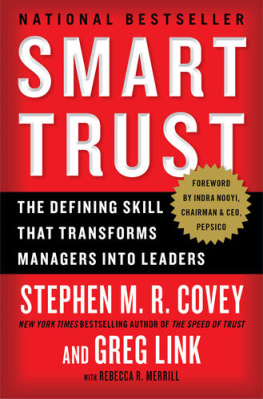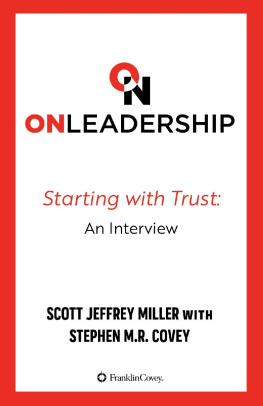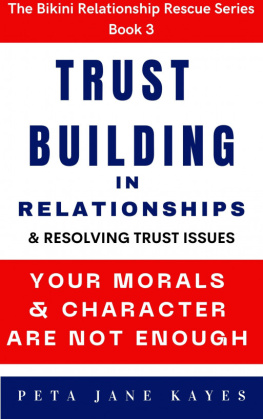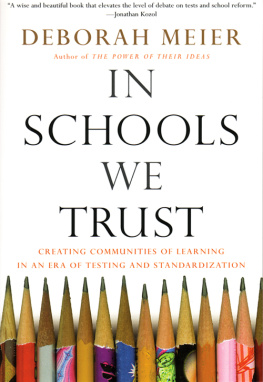
Contents
List of Illustrations
List of Tables
List of Exhibits
Pages
Guide
More Praise for Trust Matters
It has been awhile since I read the first edition of Trust Matters, but I remember the influence that Megan Tschannen-Morans skillful blend of story and analysis had upon my thinking and its subsequent contribution to my own work. This second edition is even better! Like the first, it is insightful, peppered with wisdom, born of experience, and shaped by intellectual endeavor. Much of this book focuses on the key roles of school leaders in responding to issues of betrayal, repair of broken trust, and the need to build bridges with parents and community in contexts of unprecedented levels of governmental and public scrutiny; and underpinning the messages, prompts for reflection at the end of each chapter give the same powerful message that trust and trustworthiness are key components in teachers and schools capacities to enhance student learning and achievement. For its humanity, closeness to practice, and evidence-based improvement messages, this book is a must-read for all educators.
Christopher Day, professor of education, University of Nottingham
For Bob, Bryn, and Evan from whom I have learned the most important lessons about Trust and for Michelle, Andrs, Jennie, Erika, and Theo who have enriched those lessons with beautiful demonstrations of the Power of Love
Trust Matters
Leadership for Successful Schools
SECOND EDITION
MEGAN TSCHANNEN-MORAN
Cover design by Adrian Morgan
Cover image: Thomas Winz | Getty
Copyright 2014 by Megan Tschannen-Moran. All rights reserved.
Published by Jossey-Bass
A Wiley Brand
One Montgomery Street, Suite 1200, San Francisco, CA 941044594www.josseybass.com
No part of this publication may be reproduced, stored in a retrieval system, or transmitted in any form or by any means, electronic, mechanical, photocopying, recording, scanning, or otherwise, except as permitted under Section 107 or 108 of the 1976 United States Copyright Act, without either the prior written permission of the publisher, or authorization through payment of the appropriate per-copy fee to the Copyright Clearance Center, Inc., 222 Rosewood Drive, Danvers, MA 01923, 978-750-8400, fax 978-646-8600, or on the Web at www.copyright.com. Requests to the publisher for permission should be addressed to the Permissions Department, John Wiley & Sons, Inc., 111 River Street, Hoboken, NJ 07030, 201-748-6011, fax 201-748-6008, or online at www.wiley.com/go/permissions.
Limit of Liability/Disclaimer of Warranty: While the publisher and author have used their best efforts in preparing this book, they make no representations or warranties with respect to the accuracy or completeness of the contents of this book and specifically disclaim any implied warranties of merchantability or fitness for a particular purpose. No warranty may be created or extended by sales representatives or written sales materials. The advice and strategies contained herein may not be suitable for your situation. You should consult with a professional where appropriate. Neither the publisher nor author shall be liable for any loss of profit or any other commercial damages, including but not limited to special, incidental, consequential, or other damages. Readers should be aware that Internet websites offered as citations and/or sources for further information may have changed or disappeared between the time this was written and when it is read.
Jossey-Bass books and products are available through most bookstores. To contact Jossey-Bass directly call our Customer Care Department within the U.S. at 800-956-7739, outside the U.S. at 317-572-3986, or fax 317-572-4002.
Wiley publishes in a variety of print and electronic formats and by print-on-demand. Some material included with standard print versions of this book may not be included in e-books or in print-on-demand. If this book refers to media such as a CD or DVD that is not included in the version you purchased, you may download this material at http://booksupport.wiley.com. For more information about Wiley products, visit www.wiley.com.
Library of Congress Cataloging-in-Publication Data
Tschannen-Moran, Megan, date
Trust matters: leadership for successful schools/Megan Tschannen-Moran.Second edition.
pages cm
Includes bibliographical references and index.
ISBN 978-1-118-83437-4 (pbk.); ISBN 978-1-118-83798-6 (pdf); ISBN 978-1-118-83795-5 (epub)
1. School supervisionUnited StatesCase studies. 2. Teacher-principal relationshipsUnited StatesCase studies. 3. Educational leadershipUnited StatesCase studies. I. Title.
LB2806.4.T77 2014
371.203dc23
2013043616
PREFACE
Once upon a record-breaking cold Chicago morning, my husband, Bob, then a young inner-city pastor, got a call from a church member with a disability saying that she would like to go to church. Being kind-hearted, with an indomitable spirit, Bob was determined to get her to church despite the obstacles. He had to borrow a car, start it, and warm it up in subzero temperatures. With persistence, he was able to get the car started and running. Presently, however, the engine light came on and the smell of smoke ignited an alarming realization: the oil was frozen in the oil pan. Without lubrication, the engine had overheated and diedresulting in a costly repair to replace the engine.
This incident has much to teach us about trying to run a school without trust. Trust serves as a lubricant of organizational functioning; without it, schools are likely to experience the overheated friction of conflict as well as a lack of progress toward their admirable goals. There is no way to lead schools successfully without building, establishing, and maintaining trust within and across the many and varied constituencies they serve. With trust, schools are much more likely to benefit from the collaborative and productive efforts of their faculty and staff, which in turn help generate the results for students that educators yearn for.
Schools once enjoyed the implicit trust of their community and school leaders felt they could take for granted the trust of both their internal and external constituencies. School leadership was, by and large, a high-status, low-stress job. Now, too often, it is the reverse. We live in an era in which all of our social institutions and their leaders have come under unprecedented scrutiny. As a result, trust has become increasingly difficult for leaders to earn and maintain in our complex and rapidly changing world. This trend away from trust poses a special challenge for school leaders because trust is so vital for schools in fulfilling their fundamental mission of teaching students to be engaged and productive citizens. Understanding the nature and meaning of trust in schools has, therefore, taken on added urgency and importance. School leaders need to appreciate and cultivate the dynamics of trust to reap its benefits for greater student achievement as well as for improved organizational adaptability and productivity.
Without trust, schools are unlikely to be successful in their efforts to improve and to realize their core purpose. I have written this book to offer school leaders practical, hands-on advice on not only how to establish and maintain trust but also how to repair trust if and when it has been damaged. To illustrate how the dynamics of trust play out in schools, I have integrated into this book the case studies of three principals: one who succeeded in cultivating the trust of her faculty, and two who, although well intentioned, were unsuccessful in harnessing the vital resource of trust, and whose schools therefore suffered impaired effectiveness. Through these case studies, I hope to show the role school leaders play in fostering high-trust relationships among teachers, students, and parents. Although the names used in these stories are pseudonyms, the case studies themselves are based on real principals and interviews with teachers who worked in their schools. Each of the three principals led an elementary school with a population of primarily low-income and minority students; the three schools were within a few miles of one another in the same urban school district. But the similarities ended there. The approaches they took to school leadershipand, subsequently, the relationships they built with their faculty and staff memberswere very different. These cases provide vivid examples of the ways in which even well-meaning school leaders can end up engendering the distrust of their faculty and the high cost that is inevitably paid when that occurs: morale plummets, productivity declines, and schools lose good people.
Next page










